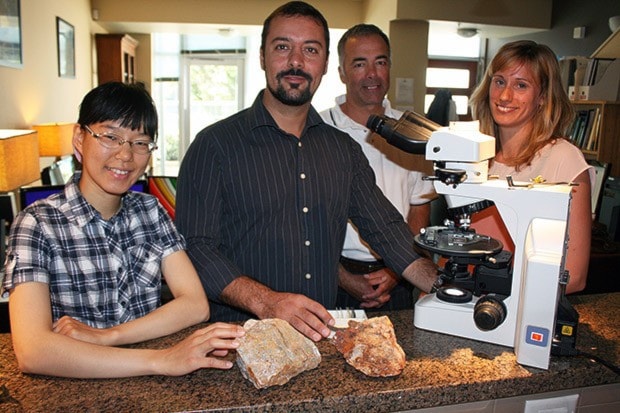The noise of excavation is overwhelming as giant machines dig deep across the street from the Artisanal Gold Council.
Such is life in the converted two-floor downtown Victoria loft, which will soon be dwarfed by the large building currently under construction.
The team of geochemists, geologists, geoscientists and toxicologists, and others that make up the Artisanal Gold Council is down to four at the moment, as some members are on vacation while others are in the field, which means an extended site visit to a small-scale gold mine in West Africa, Peru or Indonesia.
Open pit mining is one of the most common methods they see, especially in Senegal or Burkina Faso, two countries they’ve been invested in for years. Which is why it’s too obvious for them not to notice the excavation of a 10-storey Victoria development next door.
“All jokes aside, our mandate is to improve the lives of artisanal or small-scale gold miners and mining communities across the world,” says Paleah Black Moher, the team’s toxicologist.
Moher is also doing her postdoc through the University of Victoria, which is where the executive director Kevin Telmer, a geochemist, started the Artisanal Gold Council in 2008 as an associate professor with the School of Ocean Sciences. The project has grown to become a flourishing not-for-profit aiding the health and economy of mining communities around the world, in accordance with the 2013 UN-led Minimata Convention on Mercury.
The convention aims to phase out the use of mercury in the small-scale mining sector, particularly artisanal and small-scale gold mining, Moher said.
“Mercury is common with small-scale gold miners around the world. Rocks are ground down and mercury plays a key role in binding the gold together,” she added.
The problem is, not only is the mercury entering the miners’ bodies through their skin when they handle it, but family and community members often oversee the final process. The mercury is heated and the vapour released into the air.
The AGC has devised an approach that introduces more effective gold mining – doubling the yield – while also removing the mercury. They introduce technology such as a shaking sluice box, which uses water to separate gold from the gravel, and even recaptures the water for reuse.
When the price of gold spiked in 2001, workers in gold-rich countries such as Burkina Faso and Senegal, two of the poorest in the world, flocked to small-scale gold mines. Many also work on farms during the rainy season, but the land is not ideal for growing, and the dry season is eight months of the year.
“Entire families and villages depend on gold as an income, so we’re not there to do anything but encourage it in a healthier and more sustainable way,” said technical director Ricardo Rossin.
Mike Williamson, AGC vice-president of operations, is one of the few non-scientists on the team. He’s now in his fourth month with AGC after 30 years in the Canadian Forces where he did similar work in project management.
“Gold supports 70 million people in the world and we estimate small-scale gold mining supports 15 to 20 million, where they earn 70 to 80 per cent of the gold’s spot price.”
To build awareness, AGC created Mercurywatch.org, a world map indicating the highest concentration of mercury.
In addition to the technical intervention AGC agents do with small-scale mines, they also work to ‘legalize’ the mines, which are often informal and off the radar.
“In some instances the [small] mines are on the same property as a large-scale operation so we’ll liaise between the two,” Rossin said.
Two of the most important values AGC stand by are a refusal to work in a conflict zone or with child labour.
